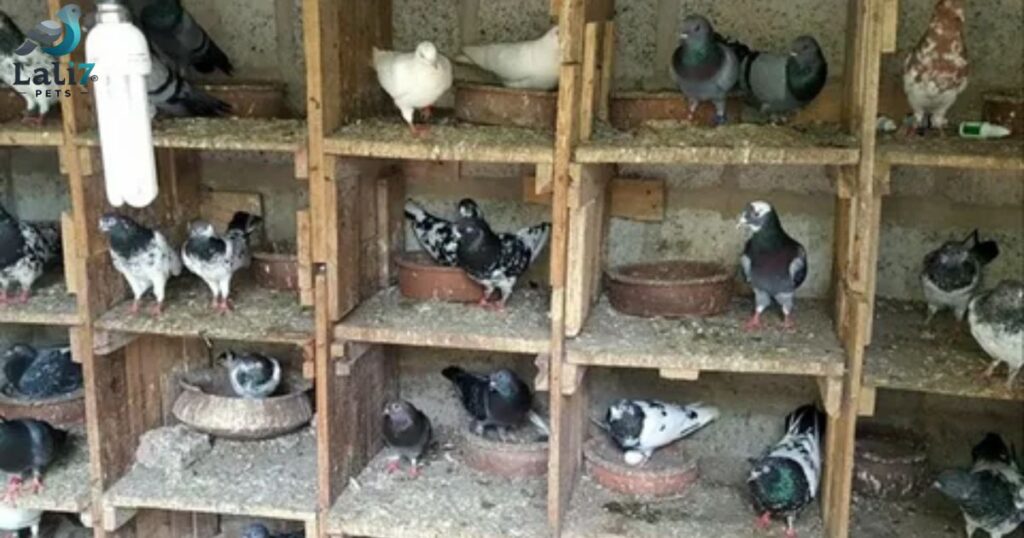Choosing the right pigeon breeding cage is the first step toward raising healthy, productive birds. Whether you’re a hobbyist or running a full-scale pigeon farm, your cage is more than just a structure it’s the foundation for comfort, health, and successful breeding.
In this detailed guide, we’ll explore everything you need to know: from cage sizing and nesting boxes to DIY tips, indoor cage designs, and the advantages of aluminum pigeon crates.
🪺 Pigeon Breeding Cage Size: How Much Space Does a Pair Need?

When it comes to pigeon breeding, size matters.
Each pair of pigeons, especially with chicks, needs ample space to stretch, roost, and care for their young. A cramped environment leads to stress, injury, and poor breeding outcomes.
🔍 Ideal Cage Size Per Pair
- Minimum dimensions: 24″ (W) × 24″ (D) × 20″ (H)
- For a breeding setup with 2 adults and 2 young ones, this is the minimum required.
- For larger flocks, modular systems like 3-tier 12-nest cages or 4-tier 16-nest cages are space-efficient.
📌 Pro Tip: Allocate 2 feet per bird, and always consider growth and future pairing needs.
📦 Pigeon Breeding Boxes: Essential for Nesting Success
A proper pigeon breeding cage is incomplete without nesting boxes. These boxes give your birds privacy, comfort, and safety while they lay and hatch eggs.
What Makes a Great Nesting Box?
- Made from durable polyethylene
- Designed with ventilation holes for airflow
- Easy to clean and disinfect
🔨 Pigeon Breeding Cage DIY: Build Your Own at Home
If you’re on a budget or love working with your hands, building a pigeon breeding cage DIY project can be fulfilling and cost-effective.
Tools & Materials Needed:
- Galvanized steel mesh (or wood if budget-bound, but less ideal)
- Metal/wooden frame
- Screws, hinges, cutting tools
- Feeding and drinking cups
- Nest boxes or baskets
Step-by-Step Mini DIY Guide
- Measure & cut your materials based on a 24x24x20-inch template.
- Assemble the frame using screws or welding.
- Attach mesh panels for walls, floor, and roof.
- Install a nest box and feeders inside.
- Add a removable tray below the cage for waste.
🏠 Pigeon Cage Indoor Setup: Breeding in Limited Spaces
For breeders living in apartments or areas with limited outdoor access, an indoor pigeon cage offers a practical solution.
Benefits of an Indoor Cage:
- Controlled temperature and lighting
- Protection from predators and weather
- Easier monitoring and management
Make sure your indoor pigeon breeding cage includes:
- Proper ventilation (add small fans if needed)
- UV lighting or near a sunny window
- Silent surroundings for stress-free lying
🧽 Place it on a raised stand with a washable manure tray underneath for hygiene.
🚚 Aluminum Pigeon Crates: Durable and Portable Options
When transporting pigeons or setting up temporary breeding spaces, aluminum pigeon crates are a top choice.
Why Choose Aluminum Crates?
- Lightweight and strong, easy to carry and stack
- Rust-resistant and long-lasting
- Great airflow and visibility
- Ideal for both transport and quarantine breeding
Perfect for breeders attending pigeon shows, races, or even starting temporary breeding stations.
🧼 Don’t Forget Hygiene and Health
Regardless of whether you choose a prebuilt or DIY cage, maintenance is key.
Cage Cleaning Checklist:
- Remove droppings every 2–3 days
- Replace nesting materials weekly
- Disinfect feeding and watering tools
- Regularly check the mesh for sharp edges or rust
🧪 Use vet-recommended cleaning solutions to avoid respiratory infections like paramyxovirus.
🔁 Summary Table for Quick Comparison
| Feature | DIY Cage | 3-Tier Cage | Indoor Cage | Aluminum Crate |
| Cost | $ | $$ | $$ | $$$ |
| Portability | ❌ | ❌ | ❌ | ✅ |
| Breeding Pair Capacity | 1–2 | 12–16 | 1–4 | 1–2 |
| Lifespan | 3–5 yrs | 10–20 yrs | 5–10 yrs | 10+ yrs |
| Hygiene Management | Manual | Built-in | Easy | Moderate |
Frequently Asked Question
Q1: How big should a pigeon breeding box be?
A pigeon breeding box should be approximately 12–14 inches wide, 12 inches deep, and 10–12 inches high to comfortably fit a pair and their nest.
Q2: What cage is best for a pigeon?
The best cage for pigeons is a well-ventilated, galvanized steel cage with at least 24″x24″x20″ per pair, including nesting and perching space.
Q3: What are the three methods of breeding pigeons?
The three main breeding methods are natural mating, forced pairing, and selective or pedigree breeding for desired traits.
Q4: How do you increase pigeon breeding?
You can increase breeding by ensuring a nutritious diet, clean environment, proper lighting, and pairing healthy, mature pigeons.
Q5: How to make pigeons mate faster?
To speed up mating, provide a quiet space, comfortable nesting boxes, and house male and female pigeons together during the breeding season.
✅ Final Word: Choose Your Pigeon Breeding Cage Wisely
A high-quality pigeon breeding cage creates the ideal environment for your birds to thrive, mate, and raise healthy chicks. Whether you go with a commercial setup, build your own, or manage them indoors, always prioritize:
- Comfort
- Cleanliness
- Ventilation
- Secure nesting

